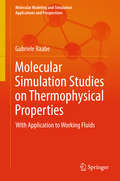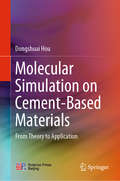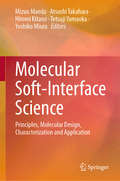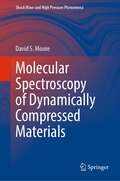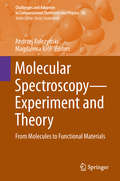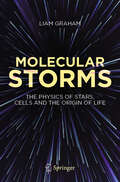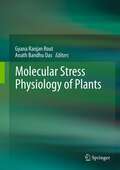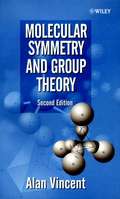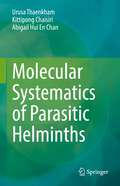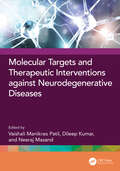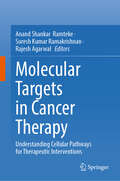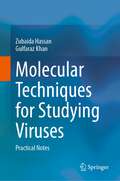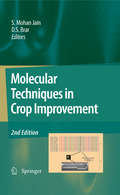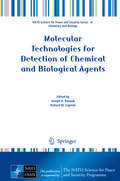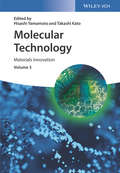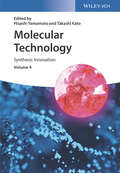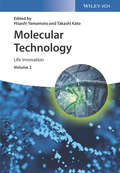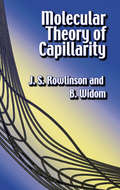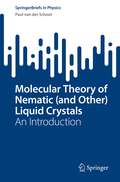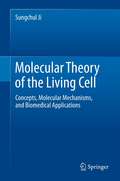- Table View
- List View
Molecular Simulation Studies on Thermophysical Properties
by Gabriele RaabeThis book discusses the fundamentals of molecular simulation, starting with the basics of statistical mechanics and providing introductions to Monte Carlo and molecular dynamics simulation techniques. It also offers an overview of force-field models for molecular simulations and their parameterization, with a discussion of specific aspects. The book then summarizes the available know-how for analyzing molecular simulation outputs to derive information on thermophysical and structural properties. Both the force-field modeling and the analysis of simulation outputs are illustrated by various examples. Simulation studies on recently introduced HFO compounds as working fluids for different technical applications demonstrate the value of molecular simulations in providing predictions for poorly understood compounds and gaining a molecular-level understanding of their properties. This book will prove a valuable resource to researchers and students alike.
Molecular Simulation on Cement-Based Materials: From Theory to Application
by Dongshuai HouThis book presents a number of studies on the molecular dynamics of cement-based materials. It introduces a practical molecular model of cement-hydrate, delineates the relationship between molecular structure and nanoscale properties, reveals the transport mechanism of cement-hydrate, and provides useful methods for material design. Based on the molecular model presented here, the book subsequently sheds light on nanotechnology applications in the design of construction and building materials. As such, it offers a valuable asset for researchers, scientists, and engineers in the field of construction and building materials.
Molecular Soft-Interface Science: Principles, Molecular Design, Characterization and Application
by Tetsuji Yamaoka Mizuo Maeda Atsushi Takahara Hiromi Kitano Yoshiko MiuraThis book offers a comprehensive treatment of the molecular design, characterization, and physical chemistry of soft interfaces. At the same time, the book aims to encourage the fabrication of functional materials including biomaterials. During the past few decades there has been steady growth in soft-interface science, and that growth has been especially rapid in the twenty-first century. The field is interdisciplinary because it involves chemistry, polymer science, materials science, physical chemistry, and biology. Based on the increasing interdisciplinary nature of undergraduate and graduate programs, the primary goal of this present work is to serve as a comprehensive resource for senior-level undergraduates and for graduate students, particularly in polymer chemistry, materials science, bioconjugate chemistry, bioengineering, and biomaterials. Additionally, with the growing interest in the fabrication of functional soft materials, this book provides essential fundamental information for researchers not only in academia but also in industry.
Molecular Spectroscopy of Dynamically Compressed Materials (Shock Wave and High Pressure Phenomena)
by David S. MooreThis book offers historical and state-of-the-art molecular spectroscopy methods and applications in dynamic compression science, aimed at the upcoming generation in physical sciences involved in studies of materials at extremes. It begins with addressing the motivation for probing shock compressed molecular materials with spectroscopy and then reviews historical developments and the basics of the various spectroscopic methods that have been utilized. Introductory chapters are devoted to fundamentals of molecular spectroscopy, overviews of dynamic compression technologies, and diagnostics used to quantify the shock compression state during spectroscopy experiments. Subsequent chapters describe all the molecular spectroscopic methods used in shock compression research to date, including theory, experimental details for application to shocked materials, and difficulties that can be encountered. Each of these chapters also includes a section comparing static compression results. The last chapter offers an outlook for the future, which leads the next-generation readers to tackling persistent problems.
Molecular Spectroscopy, Second Edition
by Jeanne L. MchaleThis textbook offers an introduction to the foundations of spectroscopic methods and provides a bridge between basic concepts and experimental applications in fields as diverse as materials science, biology, solar energy conversion, and environmental science. The author emphasizes the use of time-dependent theory to link the spectral response in the frequency domain to the behavior of molecules in the time domain, strengthened by two brand new chapters on nonlinear optical spectroscopy and time-resolved spectroscopy. Theoretical underpinnings are presented to the extent necessary for readers to understand how to apply spectroscopic tools to their own interests.
Molecular Spectroscopy—Experiment and Theory: From Molecules to Functional Materials (Challenges and Advances in Computational Chemistry and Physics #26)
by Andrzej Koleżyński Magdalena KrólThis book reviews various aspects of molecular spectroscopy and its application in materials science, chemistry, physics, medicine, the arts and the earth sciences. Written by an international group of recognized experts, it examines how complementary applications of diverse spectroscopic methods can be used to study the structure and properties of different materials. The chapters cover the whole spectrum of topics related to theoretical and computational methods, as well as the practical application of spectroscopic techniques to study the structure and dynamics of molecular systems, solid-state crystalline and amorphous materials, surfaces and interfaces, and biological systems. As such, the book offers an invaluable resource for all researchers and postgraduate students interested in the latest developments in the theory, experimentation, measurement and application of various advanced spectroscopic methods for the study of materials.
Molecular Storms: The Physics of Stars, Cells and the Origin of Life
by Liam Graham“Following in the footsteps of Stephen Hawking's ‘A brief history of time’ and Simon Singh's ‘Fermat’s Last Theorem’ this exceptionally accessible book will you leave marveling at the wonders of the world and, if you didn't listen to your science teachers, wishing you had. Graham writes with the mind of a physicist and the soul of a poet.” Nicki Hayes, CCO, The Communications Practice, author of First Aid for Feelings. “Only a few writers have managed to turn the highly technical jargon of science into language accessible for interested lay readers. Isaac Asimov showed us how it could be done, and Carl Zimmer and Brian Greene are continuing today. In Molecular Storms, his first book, Liam Graham has shown that he has the essential quality required to join this group, a love of first learning then explaining how the universe works." David Deamer, Professor of Biomolecular Engineering, University of California, Santa Cruz, author of Assembling Life.Why is the universe the way it is? Wherever we look, we find ordered structures: from stars to planets to living cells. This book shows that the same driving force is behind structure everywhere: the incessant random motion of the components of matter. Physicists call it thermal noise. Let’s call it the molecular storm.This storm drives the fusion reactions that make stars shine. It drives whirlpools and currents in atmospheres and oceans. It spins and distorts molecules until they are in the right orientation to react and form new substances. In living cells, it drives proteins to fold and molecules to self-assemble. It is behind every detail of the astonishing molecular machines that control cellular processes.Using cutting-edge research, “Molecular Storms” takes us on a dazzling journey from the early universe to the interior of the smallest living things. There, in a nanoscale world of biological devices, it explains the physics behind the chemical system which we call Life.Whether you're someone with a general interest in science or a student looking to add context to your studies, this book is for you. "Molecular Storms" is an accessible and captivating read that will deepen your appreciation of the power of science to explain the world.
Molecular Stress Physiology of Plants
by Anath Bandhu Das Gyana Ranjan RoutCrop growth and production is dependent on various climatic factors. Both abiotic and biotic stresses have become an integral part of plant growth and development. There are several factors involved in plant stress mechanism. The information in the area of plant growth and molecular mechanism against abiotic and biotic stresses is scattered. The up-to-date information with cited references is provided in this book in an organized way. More emphasis has been given to elaborate the injury and tolerance mechanisms and growth behavior in plants against abiotic and biotic stresses. This book also deals with abiotic and biotic stress tolerance in plants, molecular mechanism of stress resistance of photosynthetic machinery, stress tolerance in plants: special reference to salt stress - a biochemical and physiological adaptation of some Indian halophytes, PSII fluorescence techniques for measurement of drought and high temperature stress signal in crop plants: protocols and applications, salicylic acid: role in plant physiology & stress tolerance, salinity induced genes and molecular basis of salt tolerance mechanism in mangroves, reproductive stage abiotic stress tolerance in cereals, calorimetry and Raman spectrometry to study response of plant to biotic and abiotic stresses, molecular physiology of osmotic stress in plants and mechanisms, functions and toxicity of heavy metals stress in plants, submergence stress tolerance in plants and adoptive mechanism, Brassinosteroid modulated stress responses under temperature stress, stress tolerant in plants: a proteomics approach, Marker-assisted breeding for stress resistance in crop plants, DNA methylation associated epigenetic changes in stress tolerance of plants and role of calcium-mediated CBL-CIPK network in plant mineral nutrition & abiotic stress. Each chapter has been laid out with introduction, up-to-date literature, possible stress mechanism, and applications. Under abiotic stress, plant produces a large quantity of free radicals, which have been elaborated. We hope that this book will be of greater use for the post-graduate students, researchers, physiologist and biotechnologist to sustain the plant growth and development.
Molecular Structure and Biological Activity of Steroids
by Martin BohlMolecular Structure and Biological Activity of Steroids focuses on the indentification of steroid structural features that control particular biological effects. Steroid geometry plays a critical role in steroid activity; therefore, the results of X-ray crystallographic, NMR spectroscopic, and theoretical studies on structure-activity relationships form an integral part of the book. Well-established observations and proposed models are presented, summarizing knowledge of molecular features (e.g., steroid backbone structures, side-chain constitutions, substitution sites, configurations, hydrogen-bonding patterns) that can affect steroid action. The book also provides overviews about recent progress in various frontier fields of steroid research, including such areas as sex steroids, glucocorticoids, aromatase inhibitors, vitamin D metabolites, brassinosteroids, neuromuscular blocking agents, and cardiotonic steroids. Molecular Structure and Biological Activity of Steroids is a "must-have" resource for biochemists, pharmacologists, endocrinologists, biophysicists, and others actively involved in steroid research.
Molecular Structures and Structural Dynamics of Prion Proteins and Prions
by Jiapu ZhangThis monograph is the first easy-to-read-and-understand book on prion proteins' molecular dynamics (MD) simulations and on prions' molecular modelling (MM) constructions. It enables researchers to see what is crucial to the conformational change from normal cellular prion protein (PrPC) to diseased infectious prions (PrPSc), using MD and MM techniques. As we all know, prion diseases, caused by the body's own proteins, are invariably fatal and highly infectious neurodegenerative diseases effecting humans and almost all animals for a major public health concern. Prion contains no nucleic acids and it is a misshapen or conformation-changed protein that acts like an infectious agent; thus prion diseases are called "protein structural conformational" diseases. PrPC is predominant in α-helices but PrPSc are rich in β-sheets in the form as amyloid fibrils; so very amenable to be studied by MD techniques. Through MD, studies on the protein structures and the structural conversion are very important for revealing secrets of prion diseases and for structure-based drug design or discovery. Rabbits, dogs, horses and buffaloes are reported to be the few low susceptibility species to prion diseases; this book's MD studies on these species are clearly helpful to understand the mechanism underlying the resistance to prion diseases. PrP(1-120) usually has no clear molecular structures; this book also studies this unstructured region through MD and especially MM techniques from the global optimization point of view. This book is ideal for practitioners in computing of biophysics, biochemistry, biomedicine, bioinformatics, cheminformatics, materials science and engineering, applied mathematics and theoretical physics, information technology, operations research, biostatistics, etc. As an accessible introduction to these fields, this book is also ideal as a teaching material for students.
Molecular Switches, 2 Volume Set
by Wesley R. Browne Ben L. FeringaThe long-awaited second edition of the successful book covering molecular switches now in two volumes! Providing principles and applications this book brings you everything you need to know about molecular switches - a hot topic in the nanoworld. The major classes of molecular switches including catenanes, rotaxanes, azobenzenes together with polymer and biomolecular switching systems and DNA based switches are covered. Chemists and material scientists interested in one of the most innovative areas of their science will benefit greatly from reading this book. "This book will appeal most to organic chemists, because of the way new structures are introduced through their synthesis, but it will also provide a useful introduction for other scientists, provided they are conversant with molecular structures." (Organic and Biomolecular Chemistry) "... a comprehensive and up-to-date insight ..." (Chemistry & Industry)
Molecular Symmetry and Group Theory: A Programmed Introduction to Chemical Applications
by Alan VincentThis substantially revised and expanded new edition of the bestselling textbook, addresses the difficulties that can arise with the mathematics that underpins the study of symmetry, and acknowledges that group theory can be a complex concept for students to grasp. Written in a clear, concise manner, the author introduces a series of programmes that help students learn at their own pace and enable to them understand the subject fully. Readers are taken through a series of carefully constructed exercises, designed to simplify the mathematics and give them a full understanding of how this relates to the chemistry. This second edition contains a new chapter on the projection operator method. This is used to calculate the form of the normal modes of vibration of a molecule and the normalised wave functions of hybrid orbitals or molecular orbitals. The features of this book include: * A concise, gentle introduction to symmetry and group theory * Takes a programmed learning approach * New material on projection operators, and the calcultaion of normal modes of vibration and normalised wave functions of orbitals This book is suitable for all students of chemistry taking a first course in symmetry and group theory.
Molecular Systematics of Parasitic Helminths
by Urusa Thaenkham Kittipong Chaisiri Abigail Hui En ChanThis book aims to provide fundamental knowledge and information for research in molecular systematics on parasitic helminths (nematode, trematode, cestode). The shreds of evidence of molecular systematics studies will be compiled and discussed in terms of the utilities and pitfalls of the genetic marker used for various purposes, which have been implemented for molecular systematics of parasitic nematodes, cestodes, and trematodes. Moreover, this book will also provide the procedure for research on molecular systematics and DNA taxonomy as the guideline to explore parasitic helminths. Finally, the further perspectives of utilizing genetic markers for molecular studies on parasitic helminths will be addressed in the context of applications from the laboratory to fieldwork such as DNA barcoding and environmental DNA metabarcoding of parasitic helminths. The book will benefit postgraduate students and researchers requiring the detailed knowledge of molecular systematics, as well as researchers desiring a guideline to select genetic markers and analyze DNA sequences to make phylogenetic inferences
Molecular Targets and Therapeutic Interventions Against Neurodegenerative Diseases
by Vaishali Manikrao Patil, Dileep Kumar, and Neeraj MasandThis book comprehensively explores the latest advancements in the understanding, diagnosis, and treatment of neurodegenerative diseases. The chapters provide an in-depth review of current approaches and treatment strategies for Alzheimer's disease, offering insights into the latest developments and breakthroughs. It also reviews the cutting-edge research on potential novel targets for Alzheimer's pharmacotherapy, with a focus on JNK3, GSK3β, and Fyn kinase inhibitors, providing an update on related approaches and their implications. It discusses the potential of ethnomedicines as a promising tool for mitigating Alzheimer's disease, offering insights into traditional remedies and their modern applications. Additional chapters explore the influence of microglia, the neuropharmacological mechanisms associated with SARS-CoV-2, and the molecular intricacies of Parkinson’s disease. The book further covers the evolving role of artificial intelligence and machine learning in the management of neurodegenerative disorders. The chapters also examine the role of nanotechnology in addressing the challenges of diseases like multiple sclerosis. Towards the end, the book examines the role of oxidative damage in neurodegeneration and its management in related disorders. This book is an important source for neuroscientists, neurologists, and students of neuroscience.
Molecular Targets in Cancer Therapy: Understanding Cellular Pathways for Therapeutic Interventions
by Anand Shankar Ramteke Suresh Kumar Ramakrishnan Rajesh AgarwalCancer continues to be a major global health challenge. Recent breakthroughs in molecular biology and multi-omics technologies have revolutionized the understanding of disease pathology and treatment modalities. Molecular Targets in Cancer Therapy is a cutting-edge resource that explores the rapidly evolving landscape of targeted cancer treatments, offering critical insights into the molecular mechanisms driving tumors growth and progression. This comprehensive book brings together contributions from leading cancer researchers who examine a wide range of molecular targets— that are involved in hallmarks of cancer, i.e. cell signalling pathways, angiogenesis, cell death pathways, epithelial mesenchymal transitions, telomerase, immune signalling, metabolic attributes etc. Each chapter delves into the biological rationale, current therapeutic strategies, and clinical implications of targeting these molecules, offering readers both foundational knowledge and the latest advances in the field.
Molecular Techniques for Studying Viruses: Practical Notes
by Zubaida Hassan Gulfaraz KhanThis volume provides detailed information on various laboratory techniques and methodologies used for studying viruses at the molecular level. It covers essential topics such as nucleic acid isolation, protein isolation, PCR-based techniques, western blotting, serological assays, immunoprecipitation, small interfering RNA (siRNA), histological methods, bioinformatics and in silico simulations. Each chapter provides a detailed overview of the techniques, their applications, and their significance in virus research. The book is a useful resource as a practical introductory note that could be used for hands-on training of students, both undergraduates and junior postgraduates.
Molecular Techniques in Crop Improvement
by Shri Mohan Jain D. S. BrarThis book provides comprehensive information on the latest tools and techniques of molecular genetics and their applications in crop improvement. It thoroughly discusses advanced techniques used in molecular markers, QTL mapping, marker-assisted breeding, and molecular cytogenetics.
Molecular Technologies for Detection of Chemical and Biological Agents
by Joseph H. Banoub Richard M. CaprioliThis book describes the latest molecular insights needed to understand the chemical and biological (CB) agents and their associated biotechnologies. Its primary focus is to present and discuss molecular technologies such as mass spectrometry, chemical and biological sensors, chromatographic and electrophoretic separation, and comparisons of spectroscopic, immunological and molecular analyses of chemicals used for the detection of chemical and biological agents and to prevent terrorism. This NATO-ASI book also contributes to the critical assessment of existing knowledge on new and important detection technologies. It helps to identify directions for future research and to promote closer working relationships between scientists from different professional fields.
Molecular Technology, Volume 3: Materials Innovation
by Hisashi Yamamoto Takashi KatoEdited by foremost leaders in chemical research together with a number of distinguished international authors, this third volume summarizes the most important and promising recent developments in material science in one book. Interdisciplinary and application-oriented, this ready reference focuses on innovative methods, covering new developments in photofunctional materials, polymer chemistry, surface science and more. Of great interest to chemists as well as material scientists alike.
Molecular Technology, Volume 4: Synthesis Innovation
by Hisashi Yamamoto Takashi KatoEdited by foremost leaders in chemical research together with a number of distinguished international authors, this fourth volume summarizes the most important and promising recent developments in synthesis, polymer chemistry and supramolecular chemisty. Interdisciplinary and application-oriented, this ready reference focuses on innovative methods, covering new developments in catalysis, synthesis, polymers and more. Edited by foremost leaders in chemical research together with a number of distinguished international authors, this fourth volume summarizes the most important and promising recent developments in synthesis, polymer chemistry and supramolecular chemisty. Interdisciplinary and application-oriented, this ready reference focuses on innovative methods, covering new developments in catalysis, synthesis, polymers and more.
Molecular Technology: Life Innovation
by Hisashi Yamamoto Takashi KatoEdited by foremost leaders in chemical research together with a number of distinguished international authors, Volume 2 presents the most important and promising recent chemical developments in life sciences, neatly summarized in one book. Interdisciplinary and application-oriented, this ready reference focuses on methods and processes with a high practical aspect, covering new trends in drug delivery, in-vivo analysis, structure formation and much more.Of great interest to chemists and life scientists in academia and industry.
Molecular Theory of Capillarity (Dover Books on Chemistry)
by J. S. Rowlinson B. WidomHistory of thought on molecular origins of surface phenomena offers a critical and detailed examination and assessment of modern theories, focusing on statistical mechanics and application of results in mean-field approximation to model systems. Emphasis on liquid-gas surface, with a focus on liquid-liquid surfaces in the final chapters. 1989 edition.
Molecular Theory of Fluctuation in Life Phenomena
by Fumio HirataThis book describes molecular processes taking place in living cells, in which &“water&” or &“solvation&” play essential roles. The molecular processes include conformational stability, fluctuation, relaxation, self-organization, molecular recognition, and chemical reactions. In all those processes, so-called solvation free-energy, and its first and second derivatives with respect to the atomic coordinates of biomolecules play key roles. Such derivatives of the free energy may not be calculated by any method of molecular simulation, because the calculation requires an analytical formula of the solvation free energy as a function of the atomic coordinates of a biomolecule. In this book, the theory is applied to analyze phenomena closely related to the conformational and density fluctuation of biomolecular systems, including the entropy and spectroscopy of both biomolecules and solvents. The theory is further developed to give microscopic expressions to the well-regarded phenomenological theories of chemical reactions, including the Michaelis–Menten theory of the enzymatic reaction, and the theory of the electron-transfer reaction by R. Marcus. Also clarified in the book is physical basis of Anfinsen&’s hypothesis concerning the protein folding. This book is beneficial for graduate students and researchers in the field of life science and technology, especially for those studying pharmaceutical design and biomimetic technology such as artificial enzymes.
Molecular Theory of Nematic: An Introduction (SpringerBriefs in Physics)
by Paul van der SchootThis book provides a didactic derivation of the main theories of thermotropic and lyotropic liquid crystals, revealing the common molecular-theoretic framework that underpins both theories. This unified context will help young researchers in coming to grips with the basics of the simplest of liquid crystals, being uniaxial nematic liquid crystals, easing them into the intricacies of more complex forms of such materials irrespective of whether they are thermotropic or lyotropic. The coverage provides a theoretical understanding of the phase behaviour, that is, what drives molecules and particles to spontaneously align themselves, as well as an appreciation of the role of entropy, energy and so on. The focus here is on the main theories for the isotropic-nematic transition, being the Maier-Saupe and the Onsager theories, and how they are derived from a common description, known as (classical) density functional theory (DFT). This book will be a valuable resource for senior undergraduate and graduate students, and experimentalists and engineers who feel intimidated by more formal or rigorous theoretical accounts and textbooks. Exercises at the end of each chapter help the reader to apply the basic concepts also to other types of liquid crystal, in particular the smectic liquid crystal.
Molecular Theory of the Living Cell
by Sungchul JiThe book presents the first comprehensive molecular theory of the living cell ever published since the cell doctrine was formulated in 1838-1839. It introduces into cell biology over thirty key concepts, principles and laws imported from physics, chemistry, computer science, linguistics, semiotics and philosophy. The author formulates physically, chemically and enzymologically realistic molecular mechanisms to account for basic living processes such as ligand-receptor interactions, enzymic catalysis, force-generating mechanisms in molecular motors, chromatin remodelling, and signal transduction. Possible solutions to basic and practical problems facing contemporary biology and biomedical sciences have been suggested, including pharmacotherapeutics and personalized medicine.
